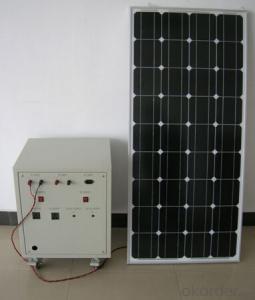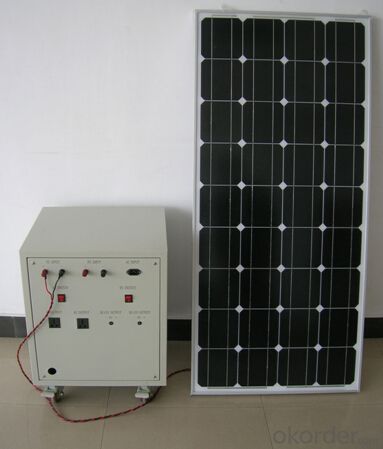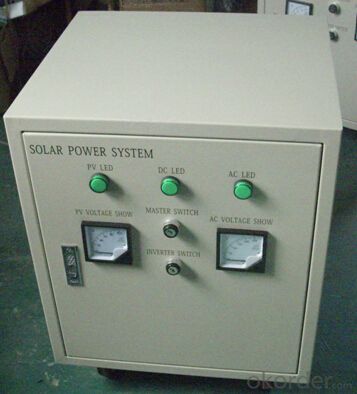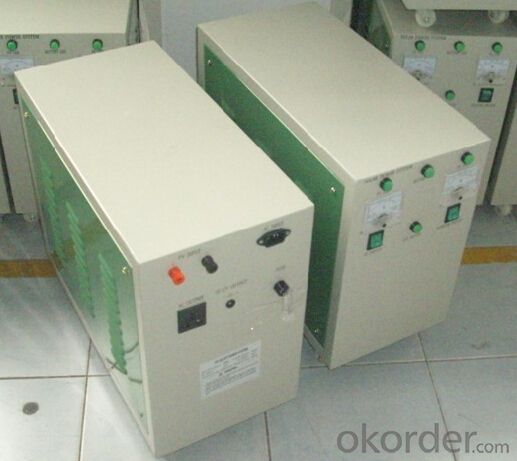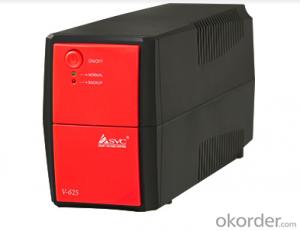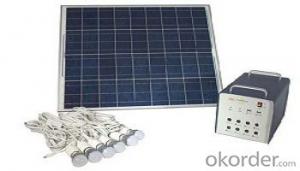CNBM Solar Home System Roof System Easy installation Capacity-300W
- Loading Port:
- Shanghai
- Payment Terms:
- TT or LC
- Min Order Qty:
- 100 PCS
- Supply Capability:
- 500000 PCS/month
OKorder Service Pledge
OKorder Financial Service
You Might Also Like
Introduction of Solar Energy
In the last two decades, photovoltaics (PV), also known as solar PV, has evolved from a pure niche market of small scale applications towards becoming a mainstream electricity source. A solar cell is a device that converts light directly into electricity using the photoelectric effect. The first solar cell was constructed by Charles Fritts in the 1880s. In 1931 a German engineer, Dr Bruno Lange, developed a photo cell using silver selenide in place of copper oxide. Although the prototype selenium cells converted less than 1% of incident light into electricity, both Ernst Werner von Siemens and James Clerk Maxwell recognized the importance of this discovery. Following the work of Russell Ohl in the 1940s, researchers Gerald Pearson, Calvin Fuller and Daryl Chapin created the crystalline silicon solar cell in 1954. These early solar cells cost 286 USD/Watt and reached efficiencies of 4.5–6%. By 2012 available efficiencies exceed 20% and the maximum efficiency of research photovoltaics is over 40%.
Introduction of Solar Home System
Solar Home System is composed by Solar Panels, Inverters, Charger Controller, Battery, Cable, Mounting Bracket, which is applied to produce electricity for home use.
Solar Home System is quite suitable product in urban area and the place which is short of electricity. As the cost of solar products reduced, more and more family can bear the charge of solar products. These products apply to schools, hospitals, public halls and private housing, communication stations, weather station. Also can use as household appliances, lighting, communications equipment, meteorological equipment.
Our company’s main target is to make every family can use cheap solar energy and enjoy the new innovation of modern science and technology.
Picture of Our Factory

Working Principle of Solar Home System
This is an off-grid solar system which uses batteries to store the solar energy, at the same time, the solar system can be connected with the grid for utilization of grid power. The solar system uses battery power in priority, but when sunshine is not so good or loads consumption is too big which caused the battery power inadequacy, then the system can switch automatically to grid power supply. Meanwhile, the system can charge the batteries with grid power until batteries are fully charged. Then the solar system will switch back to battery power supply.
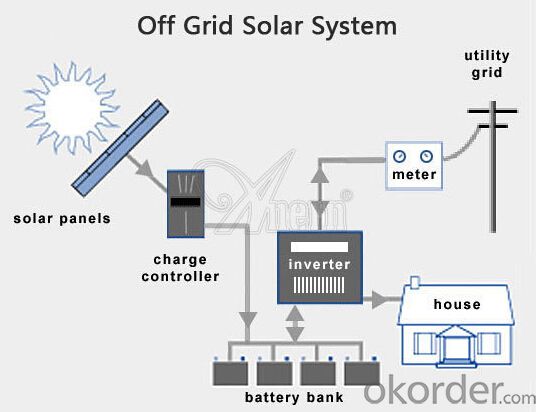
Product Details of Solar Home System
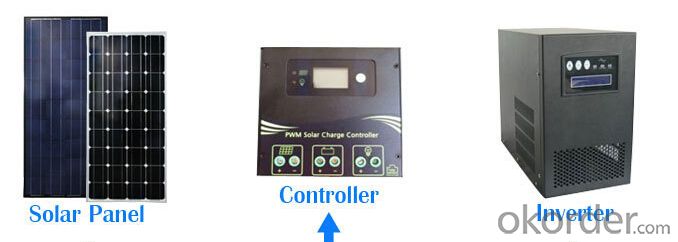


Specification of Solar Home System
Technical data: | |||||||||
Inverter | Rated load power | 1000W | |||||||
Output wave | Pure sine wave | ||||||||
Input voltage | 24V | ||||||||
Output voltage | DC:12V | ||||||||
Output frequency | 50HZ/60HZ | ||||||||
Precision of output frequency | ±6% | ||||||||
Solar panel | Pmax | 150W*2PCS | |||||||
Vmp | 36V | ||||||||
Imp | 8.34A | ||||||||
Charger | Charger voltage & current | 24V/20A | |||||||
Battery | Capacity | 12V100AH*2PCS | |||||||
Power box | Spray paint iron box,with input,output, ammeter,voltmeter,master switch and so on. | ||||||||
Package data: | |||||||||
Part | Size (L*W*H mm) | Weight (kg) | 20' (pcs) | 40' (pcs) | |||||
Power box | 580*520*540 | 60 | 84Sets | 200Sets | |||||
Solar panel | 1500*700*90 | 24 | |||||||
Solar panel bracket |
|
| |||||||
Loading electrical equipment(For consult) | |||||||||
Name of Load | Power(W) | Quantity | Working Time per Day (H) | Working Days | |||||
Color TV | 65W | 1 | 6 | 3 days | |||||
Satellite TV Receivers | 25W | 1 | 6 | 3 days | |||||
lamp | 11W | 2 | 8 | 3 days | |||||
Other | 150W |
| 2 | 3 days | |||||
Advantage of Our Solar Home System
1 Excellent Performance: Our Solar Home System is composed by Brand Standard Kits with high quality. Our solar system has the advantage of high efficiency and stable operation. We can ensure our product with a long life period.
2. Small Orders Accepted: We can accept small orders as our customer’s trial order.
3. Guarantee/Warranty: We supply 10 Years Product Warranty and 25 Years Performance warranty.
4. Warehouse: We have warehouse overseas which can bring great convenience to our customer to pick up the products.
FAQ
Q: You are a manufacturer or Trader?
A: We are a Group corp. with 1GW capacity, which is Okorder’s registered VIP Supplier, enjoy Okorder’s Financial Guarantee.
Q: Required mainly certificates (CE&IEC/TUV/RoHS)?
A: Our products are certificated by CE RoHS, IEC, C-tick etc.
Q: Your main exported market is?
A: Main markets of our products is: South-east Asia, Mid-east, Arica, East Europe and Latin America.
- Q:Are there any risks of electrical arcing with solar energy systems?
- Yes, there are risks of electrical arcing with solar energy systems. Electrical arcing can occur due to various factors such as faulty wiring, loose connections, or damaged components. This can lead to fires, damage to the system, and potential harm to individuals nearby. Therefore, proper installation, regular maintenance, and adherence to safety guidelines are crucial to minimize the risks of electrical arcing in solar energy systems.
- Q:What is the role of solar panel cleaning in maintaining optimal performance?
- Solar panel cleaning plays a crucial role in maintaining optimal performance by removing dirt, dust, bird droppings, and other debris that can accumulate on the surface of the panels. These contaminants can significantly reduce the panel's ability to absorb sunlight and convert it into electricity. Regular cleaning ensures maximum sunlight absorption, increasing the efficiency and output of the solar panels.
- Q:How much does a solar energy system cost?
- The cost of a solar energy system can vary depending on various factors such as the size of the system, location, government incentives, and installation costs. On average, a residential solar energy system can range from $10,000 to $30,000, but it is recommended to get a personalized quote from a solar installer for an accurate cost estimation.
- Q:How do solar energy systems impact the energy efficiency of buildings?
- The energy efficiency of buildings can be greatly improved by solar energy systems, which have a significant positive effect. These systems harness the power of the sun, providing clean and renewable energy that lessens the reliance on traditional fossil fuels. Consequently, this leads to a decrease in greenhouse gas emissions and aids in the fight against climate change. One of the primary methods by which solar energy systems enhance the energy efficiency of buildings is through on-site electricity generation. By directly converting sunlight into electricity, these systems eliminate the need for conventional methods of electricity generation that often result in energy losses during transmission and distribution. This on-site generation reduces the overall energy consumption of the building and minimizes energy waste. Furthermore, solar energy systems also contribute to the energy efficiency of buildings by diminishing the demand for electricity from the grid. During periods of peak energy demand, such as scorching summer days, solar panels can supply a substantial portion of a building's electricity needs, easing the strain on the grid. This not only helps stabilize the electricity supply but also decreases the necessity for additional power plants, which are frequently powered by non-renewable sources. Moreover, solar energy systems can be combined with energy storage technologies, such as batteries, to store excess electricity generated during the day for use during times of low solar generation or high energy demand. This enables buildings to become more self-sufficient in terms of energy supply and reduces reliance on the grid when electricity prices may be higher. In addition to generating electricity, solar energy systems can also be utilized for heating purposes. Solar thermal systems can be employed to heat water for domestic use or to provide space heating, further reducing the energy consumption of buildings. By directly utilizing the sun's heat, these systems eliminate the need for conventional heating methods, like gas or electric heaters, which consume significant amounts of energy. Overall, solar energy systems have a profound impact on the energy efficiency of buildings. They reduce energy consumption, minimize energy waste, lower greenhouse gas emissions, and contribute to a more sustainable and environmentally friendly energy future.
- Q:Can solar energy systems be used in all locations?
- Solar energy systems can be used in most locations, but their efficiency and effectiveness may vary depending on factors such as sunlight availability, climate, and geographical location.
- Q:Are there any safety certifications required for solar energy systems?
- Solar energy systems require safety certifications to ensure their safe operation. In most countries, these systems must meet specific safety standards and regulations before installation. These certifications guarantee that the solar panels, inverters, and other components are manufactured and installed in a way that minimizes electrical hazards, fire risks, and other safety concerns. The International Electrotechnical Commission (IEC) 61730 standard is one of the most common safety certifications for solar energy systems. It ensures that the solar panels meet strict safety requirements, including mechanical strength, resistance to environmental factors, and electrical insulation. It also includes tests for fire resistance, which is crucial to prevent potential hazards. Safety certifications are also required for solar inverters, which convert the DC generated by solar panels into the AC used in homes and businesses. The IEC 62109 standard is widely recognized for verifying that inverters meet safety requirements such as electrical insulation, protection against overvoltage and overcurrent, and proper grounding. Moreover, the installation of solar energy systems must comply with local electrical and building codes that often incorporate safety requirements. These codes guarantee correct and safe installation, including proper wiring, grounding, and protection against electrical faults. Adhering to these safety certifications and regulations is essential for solar energy system manufacturers, installers, and users. It ensures the safe and reliable operation of the systems, minimizing the risk of electrical accidents, fires, and other safety hazards. This provides peace of mind to both system owners and the surrounding community.
- Q:What are the disadvantages of using solar energy?
- One disadvantage of using solar energy is that it is dependent on the availability of sunlight. Cloudy days, nighttime, and geographical locations with limited sunlight can limit the efficiency and reliability of solar power. Additionally, the initial cost of installing solar panels and equipment can be quite high, although it is usually offset by long-term savings on energy bills.
- Q:What is the impact of air pollution on the performance of solar panels?
- Air pollution can have a significant impact on the performance of solar panels. One of the main ways it affects solar panel performance is by reducing the amount of sunlight that reaches the panels. Air pollution, such as smog and particulate matter, can scatter and absorb sunlight, resulting in a decrease in the amount of solar energy that can be absorbed by solar panels. This reduces the overall efficiency and power output of the panels. Additionally, air pollution can deposit a layer of dust, dirt, and other pollutants on the surface of solar panels. This layer can block and absorb sunlight, further reducing the amount of energy that can be harvested. The accumulation of these pollutants also creates a barrier that hinders the transmission of sunlight to the solar cells, further decreasing the efficiency of the panels. Furthermore, air pollution can lead to the corrosion of the surfaces of solar panels. Pollutants, such as sulfur dioxide and nitrogen oxides, can react with moisture in the air to form acidic compounds. These compounds can gradually degrade the protective coatings on the panels and cause damage to the cells, reducing their performance and lifespan. Overall, the impact of air pollution on the performance of solar panels is significant. It decreases the amount of sunlight that can be harvested, reduces the efficiency and power output of the panels, and can lead to damage and degradation of the panels over time. Therefore, it is crucial to consider the effects of air pollution when designing and installing solar panels to ensure optimal performance and longevity.
- Q:Can solar energy systems be used in powering airports or transportation hubs?
- Yes, solar energy systems can be used to power airports and transportation hubs. Solar power is a renewable and sustainable energy source that can be harnessed through the installation of solar panels. These solar panels can be placed on the roofs of airport buildings, parking lots, or even on the ground surrounding the airport. Solar energy can be used to power various aspects of airports and transportation hubs. For example, solar panels can generate electricity to power lighting systems, security cameras, and other electrical equipment within the airport premises. Solar power can also be used to charge electric vehicles, such as electric buses or airport shuttles, which can help reduce carbon emissions and promote a cleaner transportation system. Furthermore, solar energy systems can provide a reliable backup power source during emergencies or power outages. This is especially crucial for airports, as they need to ensure continuous operations and maintain safety measures at all times. In recent years, several airports around the world have embraced solar energy as a way to reduce their carbon footprint and operating costs. For instance, Cochin International Airport in India became the world's first fully solar-powered airport in 2015. This airport generates more than enough electricity to meet its operational needs and even feeds excess power back into the grid. Overall, incorporating solar energy systems into airports and transportation hubs is not only environmentally friendly but also economically beneficial in the long run. It helps reduce reliance on fossil fuels, lowers energy costs, and contributes to a more sustainable and greener transportation infrastructure.
- Q:Can solar energy systems be used for emergency power backup?
- Yes, solar energy systems can be used for emergency power backup. Solar panels can generate electricity during the day, even when the grid is down, and this energy can be stored in batteries to provide power during emergencies or blackouts. This allows for a reliable and sustainable source of backup power, reducing reliance on traditional generators and fossil fuels.
1. Manufacturer Overview |
|
|---|---|
| Location | |
| Year Established | |
| Annual Output Value | |
| Main Markets | |
| Company Certifications | |
2. Manufacturer Certificates |
|
|---|---|
| a) Certification Name | |
| Range | |
| Reference | |
| Validity Period | |
3. Manufacturer Capability |
|
|---|---|
| a)Trade Capacity | |
| Nearest Port | |
| Export Percentage | |
| No.of Employees in Trade Department | |
| Language Spoken: | |
| b)Factory Information | |
| Factory Size: | |
| No. of Production Lines | |
| Contract Manufacturing | |
| Product Price Range | |
Send your message to us
CNBM Solar Home System Roof System Easy installation Capacity-300W
- Loading Port:
- Shanghai
- Payment Terms:
- TT or LC
- Min Order Qty:
- 100 PCS
- Supply Capability:
- 500000 PCS/month
OKorder Service Pledge
OKorder Financial Service
Similar products
New products
Hot products
Hot Searches
Related keywords
